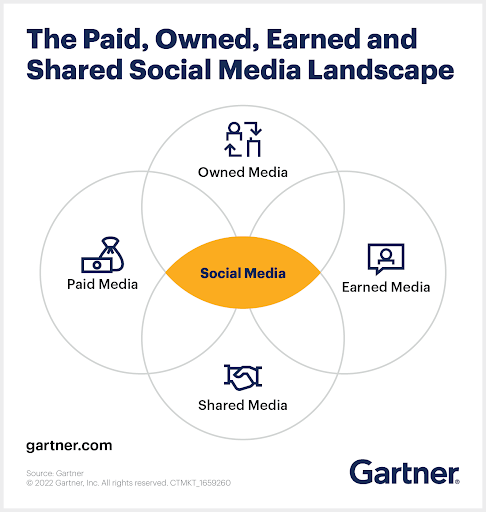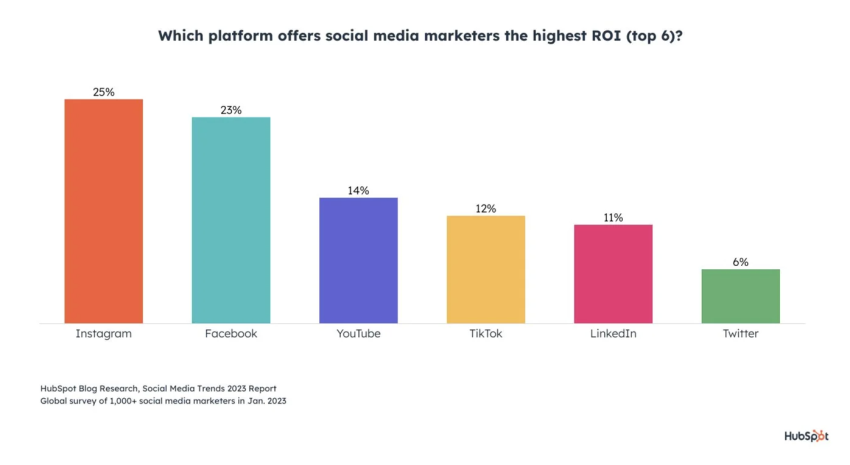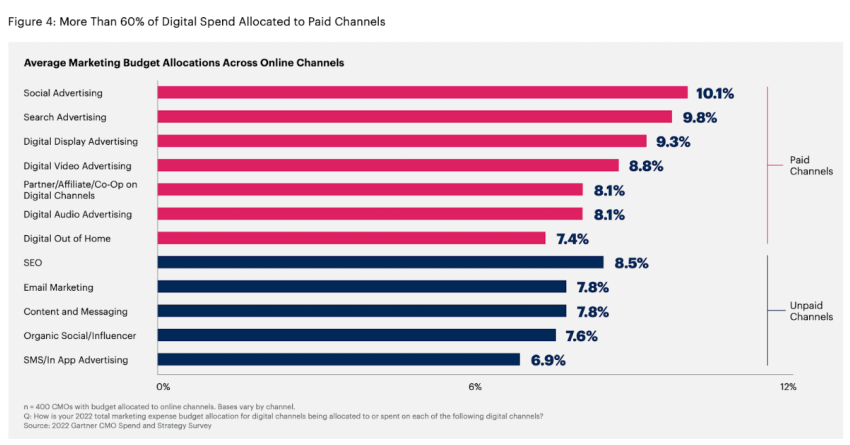Social media is so much more than posting Twitter, Facebook, and LinkedIn updates.
Before it was dubbed “social media,” it was known as “community management.” As an expert who led social media for small businesses in 2008, I’ll explain everything you should know about effective social media management.
I’ve crafted this guide for small business owners and new marketing staffers who need to develop a social media strategy and get their organization firing on all eight cylinders regarding social media channels.
What Is Social Media Management?
Social media management is the process of planning, creating, and publishing content across social networks to grow a brand’s online presence. Managing social media involves educating stakeholders, developing a marketing strategy, and establishing governance to ensure a brand’s voice and customer experience are conveyed across social media channels.

Included as essential parts of social media management are the following functions:
- Social media and marketing integration
- Business and platform-specific content plan
- Social media performance analysis
- Planning and creating content across multiple platforms
- Website content promotion
- Personalized customer support
- Brand and review monitoring
- Overseeing training and social workflows
That sounds like a lot, doesn’t it? This is why social media responsibilities are often split among several members. In a small business or startup, this might be one person (or the business owner).
You need social media management to guide the organization through social media and reach a targeted audience with engaging content and personalized support.
Unlike 15 years ago, you shouldn’t automate your social media campaigns. It’s a bad look and ineffective at persuading your audience to care about your brand and take action.

Your business should be on social media because your customers want you there, and there’s a specific business objective behind it. If neither is true, you probably don’t need social media management.
Elements of a Social Media Marketing Strategy
An effective social media strategy aligns with the brand’s overall marketing objectives and business goals.
Here are some key elements to consider for your social media marketing strategy:
Target audiences and personas
Analyze your existing customer demographics and create detailed buyer personas to determine your ideal customers on social media. Identify their age, location, gender, interests, pain points, and motivations.
It’s imperative to understand your audience’s media consumption habits. Refrain from making big bets based on hypotheticals (I’ve been burned before). Talk to your customers on the phone, get to know them as people, how they research brands, and why they use social media.
With this knowledge in hand, you’ll be ahead of 75% of others in the industry.
Target like a media buyer
Media buyers carefully consider how to reach their audience with a clear message. The goal is to stay top of mind with your targeted audience without necessarily expecting a quick ROI but engaging them with memorable ideas, strong visuals, and quick reminders of your brand.
Paid social campaigns require more than just boosting existing posts. You want to be ruthless about audience selection and engagement. Otherwise, you’ll spend thousands of dollars on bots and unqualified visitors clicking your ads.
Rather than rely solely on one platform, consider spreading your social media advertising across a few platforms for maximum reach. GaleForce Digital Technologies suggests thinking through your campaign’s demographics, creative assets, and performance metrics to be successful.
Relevant social media platforms
Research each social media platform and select the ones where your target audience is most active. Top platforms include Facebook, Instagram, Twitter, LinkedIn, YouTube, and TikTok. Consider emerging platforms as well.

By default, you might feel you need to be everywhere. You don’t need to. If nothing else, claim your brand before someone squats on your name.
Follow the money and the market. Where are your prospects? Where do customers spend most of their time? If it’s Twitter or Instagram, great. But if they primarily use LinkedIn, tailor your social media content plan around that platform.
Lastly, try to enjoy how a social network functions as a user before going full throttle with marketing messages. There’s a little truth to marketers ruining everything.
Social listening and customer support
It’s crucial to set up listening tools to be responsive to inbound questions from customers and prospects. Connect every social media profile you have into one management tool.
Prepare a plan for how you’ll handle complaints and compliments. A smart strategy is to go from public to direct messages to provide customer service.

Over time, report on the number of brand mentions and specific campaigns stemming from your marketing efforts. Social media management tools can notify you of the growth or decline across your social media presence.
Setting measurable goals
Depending on your use case or stage of your business, you might not need metrics.
Hear me out for a second.
It’s okay to explore and experiment on social media. There is no surefire template or benchmark you need to hit to prove value in your business.
Figure out what makes some brands more attractive than a pack of Double Stuffed Oreos. What are the underlying dynamics — is it the graphics, the advice, or are prominent influencers juicing up the algorithm?
Without a big audience, you will need to be creative. You will likely need to invest in promoting your social media channels. You will also need to leverage platforms such as email, video, and even your phone system.
With that said, you’ll want to consider the industry and competitors when setting targets for your social media marketing program. With defined business goals and KPIs in mind, you can analyze the effectiveness of your social media efforts.
For instance, followers matter when your audience matches your ideal customer profile, but don’t do anything unnatural to play the system.
Consider tracking engagement, traffic, and even share of voice (market share) on a given social network.
Content strategy and posting schedule
At this point, you should know a few key items: your ideal customers, what they consume on social media, and your overarching business goals. These help you craft a well-rounded content strategy for your business on social media.
Now is the time to hit the brakes and think about the purpose behind your social media content. It should not be to generate leads or sales. Yes, you read that right.
The goal behind your content is to be memorable and helpful to your audience. You don’t do that with gated webinars and whitepapers. Instead, focus on understanding the core reasons why people are interested in your product or service.
Trusted marketing advisor Gaetano DiNardi draws a line in the sand regarding “demand capture” and “demand creation.” You need both, but social media should be utilized to build genuine interest, trust, and affinity for your brand.

Digital marketing has transitioned from direct response, lead generation-focused marketing campaigns to a demand generation approach that covers brand awareness, demand creation, and demand capturing across the entire sales funnel.
Gaetano DiNardi
Having that said, here are the types of social media content to post:
- Hot takes on what’s happening in the industry
- Tips and tutorials to solve specific pain points
- Videos showing your solution or product at work
- Casual interviews with top industry voices
- Carousels and slides with original research and points of view
- Customer stories and case studies with real faces and logos
- Sneak peeks of your most recent email newsletter
- Takeaways from conferences and industry events
- Polls and genuine questions to ask your target audience
- Unexpected moments of brilliance and creativity
- Memes, newsjacking, and divisive topics, but proceed with caution
The content to post shouldn’t deviate much from your current content strategy.
Keep in mind that the goal is to earn trust and be memorable. When prospects realize they have a need, they’ll come back to you.
With a rough list of content ideas, map them out for each platform. Give yourself the flexibility not to post daily, but stick to a consistent cadence.
Each blog post you publish can be atomized or broken down into smaller assets so you can share various components that fit each social platform. You ought to ensure each post is optimized for your target audience so they can consume it easily without a high commitment.
Video-first social media content
Video is so important; you must be proactive with ideation, production, and distribution. Social media platforms are increasingly rewarding video content. Whether you build up your audience, educate your customers, or post Stories and Shorts, video is no longer optional.
Invest in building out your video team agencies alike. Align your video creation with your brand identity with a high-quality video. Focus on being valuable, authentic, and visually appealing.
While videos don’t have to be the center of your social media plan, they should still be a key component.
Utilizing paid social ads
Another area to consider is paid or performance marketing campaigns across social media. Most companies that want to grow will need additional social media advertising to distribute content to their audience.

Take all your insights about your current customers and channel them into your paid social strategy. You don’t want to burn your budget on reaching “anyone in the U.S. 18+” as you’ll get nowhere. To be cost-effective, narrow your audience and set a daily budget.
Consider starting with a remarketed audience until you nail down your brand’s social media campaigns.
Type of content to use for paid social:
- Insightful case studies and customer testimonials
- Video-based product tours with helpful context
- Deep dives into how to do something faster or easier with your brand
- Atomized blog content with a call to action to continue reading
- Recycle previously successful organic (unpaid) social media content
Social Media Management Best Practices
Setting up profiles is just the start. Managing your accounts and interacting with your followers is crucial for social media success.
- Monitor notifications: Monitor all mentions, comments, shares, and direct messages to identify opportunities for engagement.
- Post consistently: Follow your content calendar to post regularly across your social media networks without long gaps between updates.
- Implement a workflow: Develop processes between team members to streamline community management.
- Use content creation tools: Social media management tools like Nextiva or Hootsuite help teams schedule posts, engage with followers, and monitor brand mentions.
- Analyze past content: Identify post content that resonated well on social media platforms and recycle it in your scheduling tool.
By following thoughtful content marketing practices, your small team can actively manage growing social media communities as you expand your reach.
Remember that social media interactions are public, and potential customers are watching. Be cordial, prompt, and direct. The last thing you want is to copy and paste responses to people.

Types of Social Media Analytics
There are a plethora of built-in and third-party analytics tools to help track the performance of your social media efforts. Monitoring key metrics and optimizing based on insights is crucial.
- Audience growth — Are your follower numbers consistently increasing? Does the audience resemble your ideal customer?
- Engagement rate — Is your audience reacting to the content you post? This metric is expressed as a percentage of your reach.
- Impressions — Was your content seen in your audience’s news feeds?
- Reach — How many unique people could your social media content reach?
- Website clicks — How much traffic is being driven to your site from social media? This metric isn’t always a good measure of success — think about your campaign objectives.
- Conversions — When creating demand, you’ll begin attracting higher-intent leads. How many resulted in leads, pipelines, or sales from social media?
Look at performance trends over time and optimize your strategy accordingly. Consider analytics capabilities within your social media management software like Nextiva. Set up automated reports and dedicate time each month or look back at past data to achieve social media ROI.
Social Media Management Tools
Managing multiple social media accounts, engaging consistently with your community, and tracking performance is difficult without utilizing specialized social media management tools.
The primary benefit of a social media management tool is that it’s engineered to work with each social network for analytics, publishing, and even removals. It helps your team work from one dashboard instead of several distinct workflows.

We recommend budgeting approximately $300 per month for the best social media management tools and services. Plan for roughly $129 per month per user as your team grows.
Here are a few top picks:
- Nextiva—In addition to its highly rated cloud PBX platform, Nextiva offers a social media management solution for customer service and marketing teams. It includes many advanced features for a flat monthly price.
- AgoraPulse — Ideal for businesses, especially those working with a lot of paid media and having to do content moderation. Like Nextiva, it also offers a unified social inbox, social listening, and reporting tools.
- Sprout Social — Good for larger organizations and agencies with a rigorous approval workflow. Includes employee advocacy and brand monitoring capabilities.
The right social media management tool will optimize workflows, engagement, and analysis for an effective social media strategy. Consider both your budget and social media scheduling needs.
Final Thoughts on Social Media Management
A strategic approach to social media management is key for small businesses looking to drive brand awareness, website traffic, leads, and sales.
Social media has evolved a lot over the last 15 years.
Your social media strategy endures and has room to adapt to changes in the market. Pay attention to platform changes, user feedback, and your business’s practical needs.
Set relevant and attainable goals, invest in high-quality content, and set up the proper internal workflows so you can support customers and weather the storm when crises emerge.
Managing social media effectively is one of the top ways to bring your marketing strategy to life and scale your brand.

Related: How to Build a Successful Social Media Customer Service Program

















 Marketing & Sales
Marketing & Sales 









